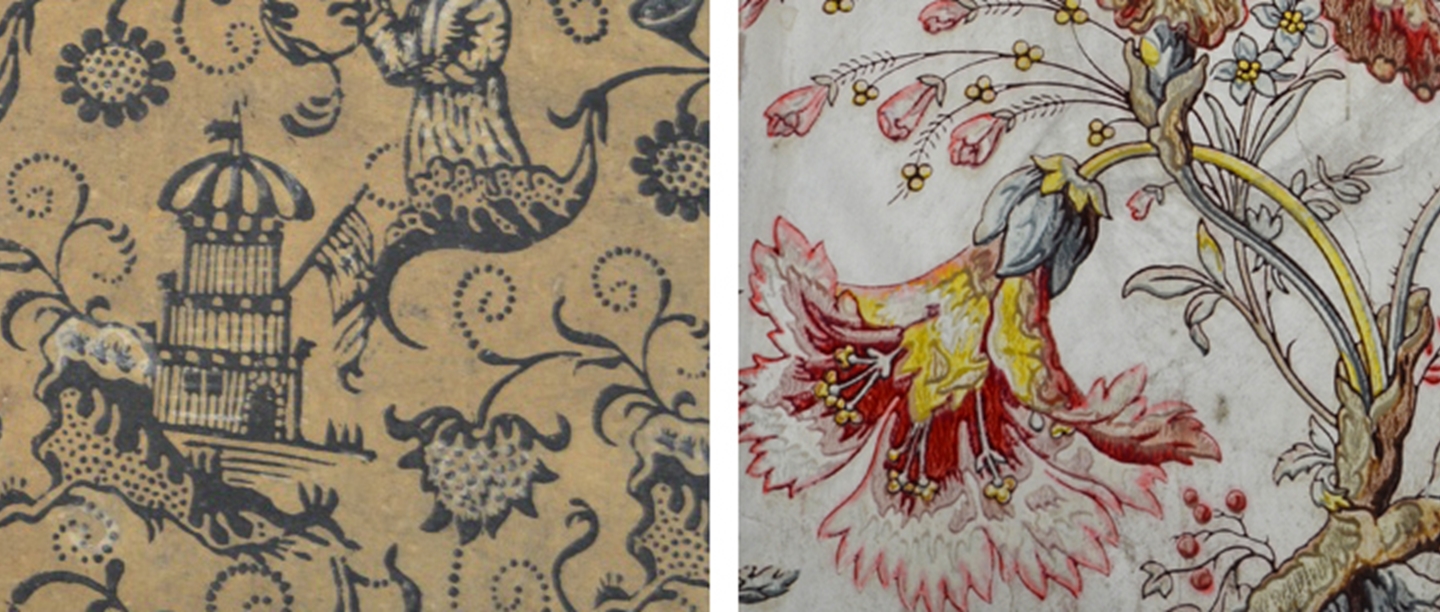
In the first of two posts, Collections Archive Assistant Rose Arkle delves into the Architectural Study Collection and explains what wallpaper can tell us, allows us to explore some of the collection and talks about recent work carried out on the wallpapers.
About The Collection
The Architectural Study Collection (ASC) is an extensive and eclectic mix of mostly 18th and 19th century architectural objects. These objects have been stored in a variety of places, but since the Collections Store opened at Wrest Park they have been securely cared for here. This large, open space makes the collections easily accessible for researchers and the public visiting Wrest Park.
The collection is unique because it gives us a visual aid that illustrates changes in London’s architecture and interiors over at least 200 years. Curator of Collections, Dr Charlotte Newman tells me that ‘collecting for the ASC began in the early 20th century by the London County Council, Historic Buildings Department. Members of the department would often salvage architectural fixtures or fittings from houses under threat of demolition or alteration.’ The collection was transferred to English Heritage in 1986 – and walking through it is one of my favourite things about my job.
For further details come on the monthly Wrest Park Stores tour…
Lead cistern and door racks in the Architectural Studies Collection
Why is Collecting Wallpaper Important?
Wallpapers are understood and researched in different ways. For example, wallpapers can demonstrate how the 19th century emerging middle classes imitated the rich through the use of wood-grain, marble, silk and chintz imitation wallpapers.
Wallpapers create atmosphere. They provide an insight into the function of a room and can reflect the taste and personality of the person decorating. Be they the pinnacle of luxury or simply functional, wallpapers add layers of meaning to an interior and add to the story of the maker or consumer.
The ASC comprises of around 1500 samples. Each of these samples provides information for research.
Exploring The Wallpaper Collection
The earliest paper in the collection dates to c.1690-1700, and it was salvaged in the 1960s from a terraced house in Paradise Row, Lambeth.
It is believed that the paper was made in the area close to St. Paul’s Churchyard, the hub of the eighteenth-century wallpaper manufacturing trade. The wallpaper portrays an array of influences in both design and method of production. The repeated design depicts Turkish figures and Japanese pagoda-like buildings.
Detailing of Turkish figure and Japanese pagoda, Paradise Row c.1690 wallpaper. This is the oldest known wallpaper in the ASC.
The earliest surviving wallpapers generally date to the 16th century. These papers were block-printed in black and sometimes with the addition of stencilling in colour. In the 18th century designs became more decorative and fruits such as pineapples and pomegranates began to feature, as did depictions of classical architecture. More expensive wall-coverings continued to be commissioned from China and these were often unique, hand-painted works. This example from the collection demonstrates how Chinese influences crept into wallpaper designs.
‘Ho Ho’ bird wallpaper extracted from the entrance hall of Crowe Hall, Bath. Now held as part of the ASC at Wrest Park in Bedfordshire
This paper depicts the ‘Ho Ho’ bird on branches. A range of flowers and foliage are incorporated into the design. The somewhat unusual ‘Ho Ho’ bird is believed to be a westernised depiction of the phoenix.
Knowing What We Have: The Wallpaper Audit
The wallpapers were recently moved to the store. They had been repeatedly moved, so it was important to take stock and carry out a location audit. This carried out over the course of about a year with volunteer assistance.
Left: Wallpaper drawers; Top right: view of the Architectural Studies Collection (ASC); Below right: inside of an oversized wallpaper box
In the first instance, we audited the collection in the wallpaper cabinets. These cabinets comprise of twenty drawers. Each drawer contains a number of wallpapers, and we needed to check that the contents of the drawers reflected what was on the list. The wallpapers in the cabinets were conserved and audited in 2012, so in most cases everything was nicely presented and accounted for.
Generally the process of the audit can be broken down into a few simple steps:
- Check the wallpaper for an accession number (the unique identifying number used for our cataloguing system)
- Using the printout to ensure the location details are correct
- Pack the wallpaper with a single sheet of acid-free paper between each sheet.
Problems arose when the location details were incorrect, if there was no visible accession number or if wallpapers were missing from the box/drawer. These changeable factors and the limited hours worked each week meant that the project took longer than previously estimated.
Find out more
The eagle-eyed will have noticed this post is part one. Part two will go into more depth on ASC wallpapers and talk about the wallpapers presented in a few of our properties over the country.
Discover the conservation work that English Heritage undertakes.